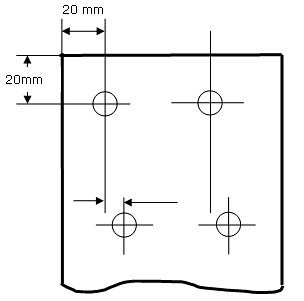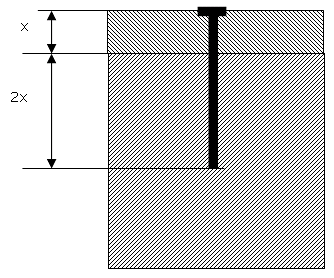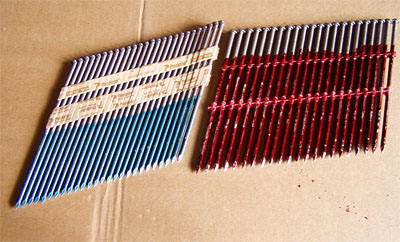Nails are the most common method of jointing wooden components when making boxes. There are many different designs of nails. The following types are used for joints between box components: round wire nails as per DIN EN 10230-1 (2000-01), nails for use in automatic nailing machines as per DIN 1143 Part 1 1982-08 or special nails as per DIN 1052 2004-08. The pull-through resistance of the head of the nail is of critical importance in the packaging industry. The pull-through resistance of the head of the nail should if possible be equal to the withdrawal resistance of the shaft of the nail. If the withdrawal resistance of the shaft of the nail is larger, the head of the nail will be pulled through the wood when a load is applied. The withdrawal resistance of the nail increases as the moisture content on processing the wood decreases:
Resin-coated nails or ring nails should preferably be used. The advantage of resin-coated nails is that when they are driven in, the frictional heat melts the resin, making the nail easier to drive. When the resin cools again, a strong bond is established between the shaft of the nail and the wood fibers. Withdrawal resistance is greater than for a nail with a smooth shaft. The annular grooves on the shaft of the ring nail guarantee a strong, tight-fit bond with the wood, which translates into a correspondingly high withdrawal resistance. The following qualitative differences in respect of withdrawal resistance can be assumed for comparable nails:
If you are clinching the components to be jointed, the chosen nail length should allow the tip of the nail to be bent (clinched) over a length of at least 5 mm. When building boxes, this is generally done by nailing on a steel nailing bed. The nail is driven through the wooden components, makes contact with the nailing bed and is bent over. The heads of the nails must not be sunk more than 2 mm and should be flush with the surface of the wood. The pattern used when nailing boards and battens must preclude splitting. This means that sufficient distance must be allowed from the edge of the boards and the nails must be offset (i.e. not all in a row). Figure 40 shows one method: 
Figure 40: Nailing pattern for boards and battens When nailing thin lumber to thick lumber, the nail length should be approximately three times the thickness of the thin lumber, as shown in Figure 41: 
Figure 41: Required nail length Nails are always driven through the thinner lumber into the thicker lumber. Nailing into the grain (parallel to the grain) results in a low withdrawal resistance and a low-strength joint and should therefore be avoided. Flat-head nails should be used for plywood to prevent the heads from pulling through the wood. When nailing plywood, care must be taken to ensure that the head does not penetrate too deeply, destroying several of the plies. 
Figure 42: Resin-coated nails for nail guns |
| Top of pageContents |
